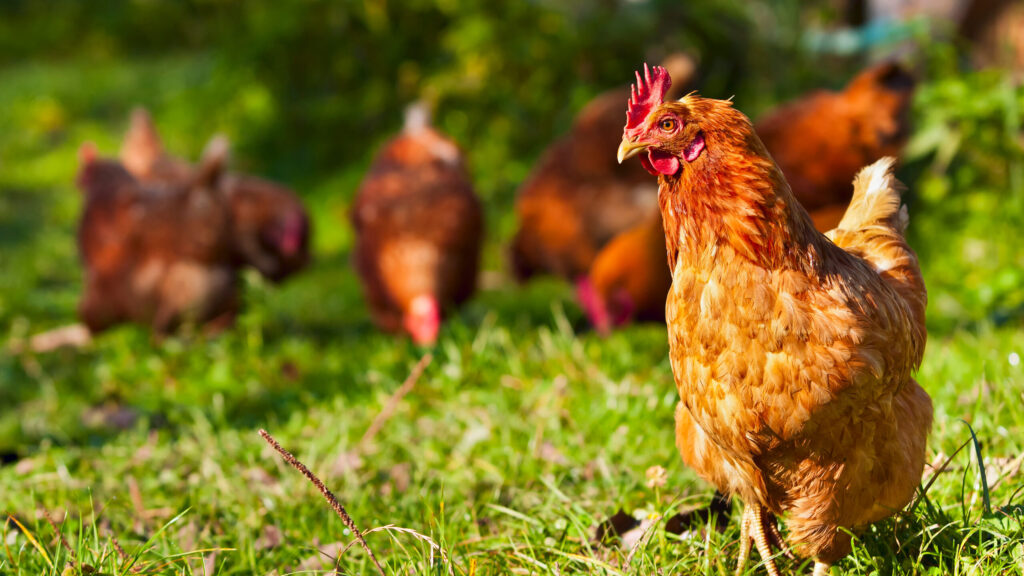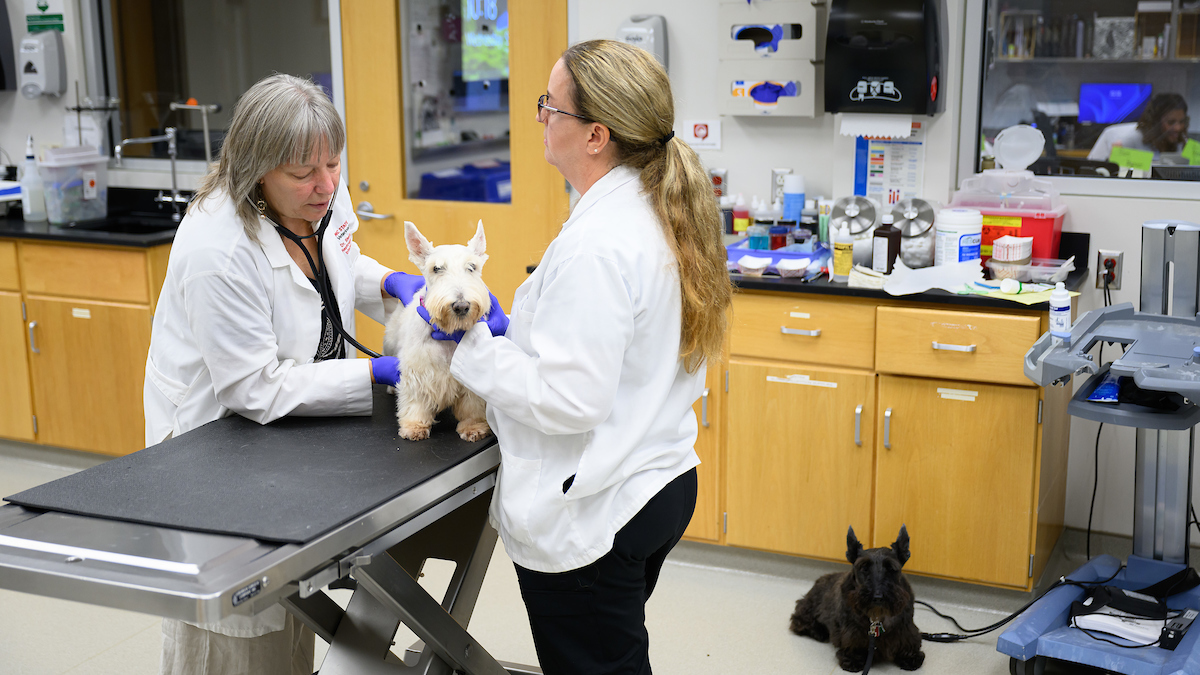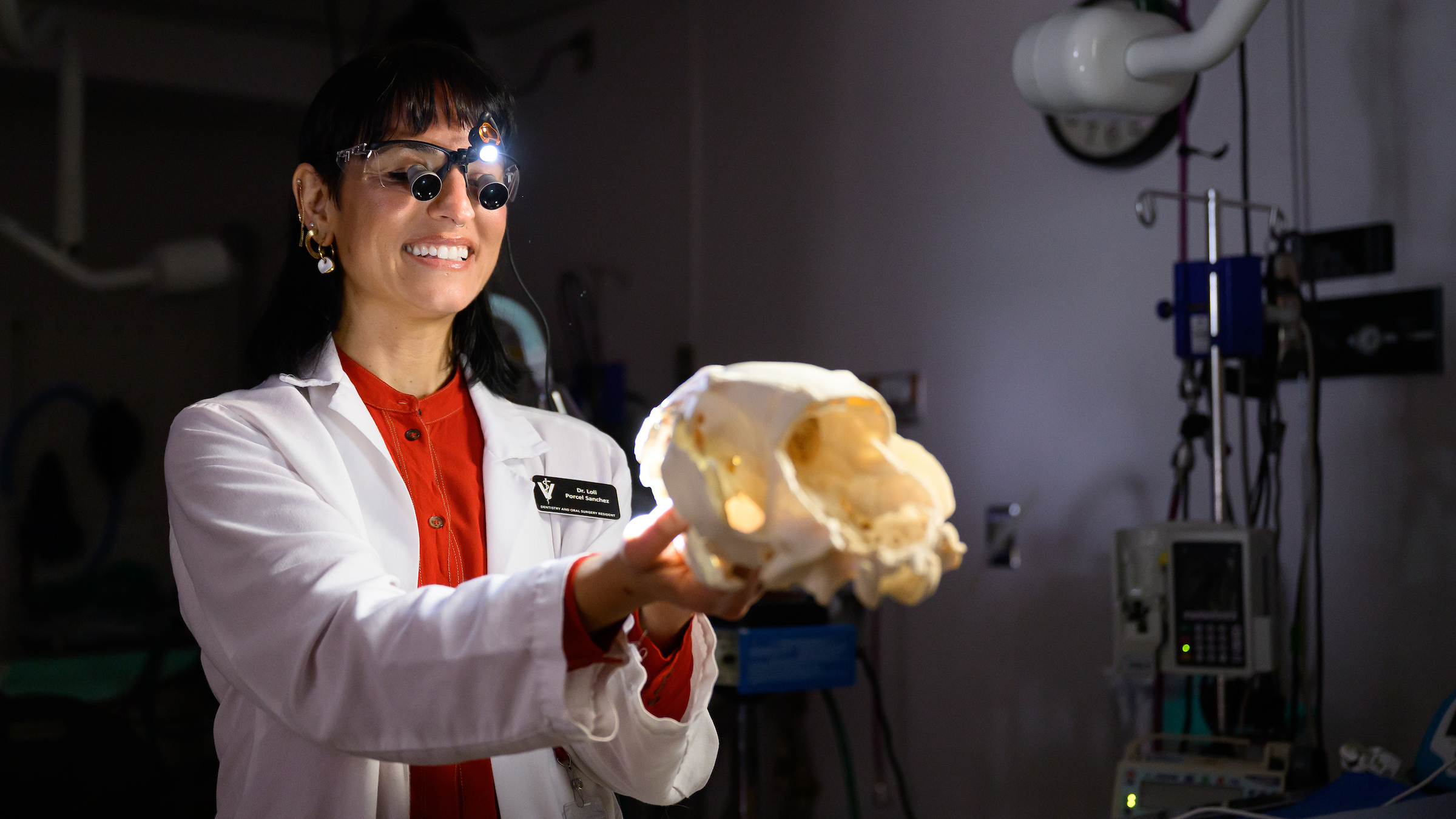Research Roundup NC State Veterinary Medicine, April 2023
Research big and small: From using dust to aid criminal investigations to improving gender equity in academic careers, CVM researchers are life-changers across the field of veterinary medicine.

Finding Alternative Treatments to C. Perfringens in Chickens
Raveendra R. Kulkarni, Carissa Gaghan, Kaitlin Gorrell, Oscar J. Fletcher
Clostridium perfringens is the bacteria that can cause necrotic enteritis, a devastating disease in chickens that can have severe economic impacts on the poultry industry. A team of researchers from NC State’s College of Veterinary Medicine, including Ravi Kulkarni, Carissa Gaghan, Kaitlin Gorrell and Oscar Fletcher, recently conducted a study to better understand a host’s immune response to the bacterium C. perfringens, with the ultimate goal of finding an effective treatment to replace antibiotics. Currently, antibiotics are the only treatment, but with the increased desire for chickens to be raised without the use of antibiotics, the team’s research is vital to discovering new treatment methods to keep flocks healthy.
The full study and its results were published in Avian Pathology and can be found here.

Using a New Vaccine Strategy Against Tick-Borne Disease in Cats
Pabasara Weerarathne, Rebekah Maker, Chaoqun Huang, Brianne Taylor, Shannon R. Cowan, Julia Hyatt, Miruthula Tamil Selvan, Shoroq Shatnawi, Jennifer E. Thomas, James H. Meinkoth, Ruth Scimeca, Adam Birkenheuer, Lin Liu, Mason V. Reichard, Craig A. Miller
Dr. Adam Birkenheuer was recently part of a multi-university collaboration that aimed to discover a vaccine to prevent Cytauxzoonosis, a severe and often fatal disease in domestic cats. The disease is caused by the tick-borne parasite Cytauxzoon felis. Unfortunately, there is no definitive cure, and the treatments that are available tend to be expensive and have only a moderate success rate. The study, which was centered on the AdHu5 vaccine, found that although vaccine did not ultimately prevent C. felis infection in the immunized cats, it did show promise as a potential treatment against cytauxzoonosis, as the cats that were vaccinated did have lower fevers and a delayed onset of other clinical signs. A clinical trial is seen as the next step in evaluating the effectiveness of these vaccines.
The study was published in Vaccines and can be found here.
Researching Household Dust as an Investigative Tool
Kelly Meiklejohn, Melissa Scheible, Laura Boggs, Robert Dunn, Darrell Ricke
Dust is often thought of as a nuisance in our households, but to crime-scene investigators, dust could hold key evidence. Often overlooked by perpetrators, dust build-up on household surfaces usually contains enough human DNA for analysis, specifically of single nucleotide polymorphisms, or SNPs. SNPs are important because they are sites within the genome that vary between individuals, and being able to identify whether DNA belongs to household occupants or perpetrators could be immensely helpful to an investigation. That’s why a recent study, including Kelly Meiklejohn, Melissa Schieble and Laura Boggs, looked at whether the software FastID could detect both known and unknown occupant SNPs in dust samples. The results of this study showed FastID is effective for detecting both known and unknown occupants. Further research is warranted to address how much time it takes for non-occupants to be detected in dust.
The full study, published in the Journal of Forensic Sciences, can be found here and a news release from NC State can be found here

Addressing Gender Differences in Research Collaborations and Academic Advancement in Veterinary Faculty
Samantha Morello, Laura Nelson, Susan Fubini
Many fields of science, including veterinary medicine, have traditionally struggled with inequity between men and women when it comes to career progression and opportunities like research collaborations. Fortunately, there are many voices within the field and, on our campus, ready to help drive change. A recent collaborative study with Cornell University, co-authored by CVM’s Laura Nelson, associate dean for academic affairs, evaluated patterns of collaborative research behavior among veterinary faculty to see whether there are differences in how men and women, particularly early in their careers, are able to access resources. The data they collected showed that even though both men and women reported high collaboration rates, opportunities and outreach were more frequent for men at both the junior and senior faculty levels. With the increasing number of female representation in recent veterinary classes, the authors highlight the need to develop more programs that focus on facilitating collaborations, especially with those early in their career, to equally set up the next generation of veterinarians for success.
The study was published in the Journal of the American Veterinary Medical Association and can be found here.
Improving Knee Surgery Techniques in Dogs
Tyler Hawbecker, Daniel Duffy, Yi-Jen Chang, George Moore
A tibial tuberosity transposition is a common surgery for dogs that is performed to correct medial patellar luxation, a condition where the kneecap does not stay in its normal position in the groove on the end of the femur. The surgery can use several techniques to secure the knee tendons and ligaments in place, including the use of thin metallic wire or a pin called Kirschner wire. A new study with Daniel Duffy, Tyler Hawbecker and Yi-Jen Chang evaluated the insertion angle, a very important part of the procedure, to determine whether placing the wire at a 0-degree orientation was more efficient than placing the wire at a 30-degree orientation. The results of the study confirmed that the placement of Kirschner wires at an angle of 0 degrees was biomechanically superior and increased the strength of the repair.
The study was published in the Veterinary and Comparative Orthopaedics and Traumatology and can be found here.
Research Connection: Novel Technology Helps Equine Athletes Stay Healthy with Dr. Lauren Schnabel
Dr. Lauren Schnabel is an associate professor of equine orthopedic surgery in the Department of Clinical Sciences at the NC State College of Veterinary Medicine. Her lab develops novel treatments and rehabilitation protocols to treat musculoskeletal injuries and diseases, with a strong focus on comparative medicine. One of the most recent studies out of her lab revolves around the EQ Press, a pneumatic compression therapy device to improve lymphatic flow in horses. Dr. Schnabel sat down with us to talk about the history behind the device and her lab’s exciting future projects!


